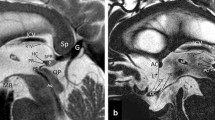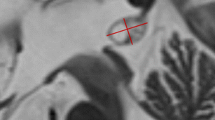Abstract
This study was undertaken to explore the anatomic features and adjacent relationships of the pineal region in thin coronal sections. After CT and MR examination verifying no brain lesions, one normal cadaver head was selected for this study from three Chinese adult male cadavers. After being embedded and frozen, the head was sliced into serial sections at 0.1 mm intervals in the coronal plane with SKC 500 computerized freezing milling machine. Then the serial coronal sections were photographed by a high-resolution digital camera and saved in the computer. Subsequently, the anatomic structures of the pineal region on the thin coronal sections were investigated and correlated with in vivo MR images, which were obtained from ten normal Chinese male adult volunteers by a 3.0 T GE scanner. The base lines of the sectioning and the MR scan were all perpendicular to the AC–PC line. A total of 355 coronal sections and 21–23 in vivo coronal MR images related with the pineal region were obtained, respectively. From anterior to posterior, the shape of the pineal region changed from an inverted triangle to a trapezoid and a triangle gradually, and the anatomic details could be depicted clearly in the thin sectional anatomy images in sub-millimeter. Via the comparison, some micro-anatomic structures of the pineal region that cannot be discriminated clearly or missed in the thick sections or MR images were identified. The contrast of the computerized freezing milling technique with the MRI enhanced our ability to comprehend the complex anatomy of the pineal region and to improve the imaging diagnosis and surgical treatments of minute diseases in this region.











Similar content being viewed by others
References
Allen JC, Nisselbaum J, Epstein F (1979) Alphafetoprotein and human chorionic gonadotropin determination in cerebrospinal fluid. An aid to the diagnosis and management of intracranial germ-cell tumors. J Neurosurg 51:368–374
Anonymous (1987) A statistical study of brain tumors in Japan: general features. The Committee of the Brain Tumor Registry in Japan. Jpn J Clin Oncol 17: 19–28
Caldas JG, Doyon D, Lederman H et al (1998) Magnetic resonance study of the pineal region. Normal pineal gland and simple cysts. Arq Neuropsiquiatr 56:237–244
Chen CY, Chen FH, Lee CC et al (1998) Sonographic characteristics of the cavum velum interpositum. AJNR Am J Neuroradiol 19(9):1631–1635
Cho BK, Wang KC, Nam DH et al (1998) Pineal tumors: experience with 48 cases over 10 years. Childs Nerv Syst 14(1–2):53–58
Edwards MS, Hudgins RJ, Wilson CB et al (1988) Pineal region tumors in children. J Neurosurg 68:689–697
Golzarian J, Balériaux D, Bank WO (1993) Pineal cyst: normal or pathological? Neuroradiology 35(4):251–253
Kenneth M, Allan H, Fukushima T (2001) Surgical approaches to pineal region tumors. J Neurooncol 54:287–299
Liu SW et al (2005) Atlas of human sectional anatomy, 1st edn. Shandong Science and Technology Press, Shandong, p 42 (in Chinese)
Mamourian AC, Yarnell T (1991) Enhancement of pineal cysts on MR images. AJNR Am J Neuroradiol 12(44):773–774
Oi S, Matsumoto S (1992) Controversy pertaining to therapeutic modalities for tumors of the pineal region: a worldwide survey of different patient populations. Childs Nerv Syst 8:332–336
Oi S, Matsuzawa K, Choi JU et al (1998) Identical characteristics of the patient populations with pineal region tumors in Japan and in Korea and therapeutic modalities. Childs Nerv Syst 14:36–40
Qian XH, Jiang JB (1995) Sectional anatomy study of human pineal region. Acta Anatomica Sinica 26(4):337–340 (in Chinese)
Qiu MG, Zhang SX, Liu ZJ et al (2004) Visualization of the temporal bone of the Chinese Visible Human. Surg Radiol Anat 26(2):149–152. doi:10.1007/s00276-003-0188-9
Sener RN (1995) The pineal gland: a comparative MR imaging study in children and adults with respect to normal anatomical variations and pineal cysts. Pediatr Radiol 25(4):245–248
Spitzer VM, Ackerman MJ, Scherzinger AL et al (1996) The visible human male: a technical report. J Am Med Inform Assoc 3(2):118–130
Williams PL (1995) Gray’s anatomy, 38th edn. Churchill Livingstone, London, pp 1888–1889
Yamamoto I (2001) Pineal region tumor: surgical anatomy and approach. J Neurooncol 54:263–275
Yamamoto I, Rhoton AL, Peace DA (1981) Microsurgery of the third ventricle: Part I. Microsurgical anatomy. Neurosurgery 8:334–356
Yao JQ, Dai HR (1992) Applied anatomy of human brain stereotaxis, 1st edn. Science and Technology Press, Hefei, pp 111–113 (in Chinese)
Korogi Y, Takahashi M, Ushio Y (2001) MRI of pineal region tumors. J Neurooncol 54:251–261
Zhen J, Liu C, Wang S et al (2007) The thin sectional anatomy of the temporal bone correlated with multislice spiral CT. Surg Radiol Anat 29(5):409–418. doi:10.1007/s00276-007-0228-y
Acknowledgments
This work was supported by National Natural Science Foundation of China (NSFC, No. 30470905).
Author information
Authors and Affiliations
Corresponding author
Rights and permissions
About this article
Cite this article
Sun, B., Tang, Y.C., Fan, L.Z. et al. The pineal region: thin sectional anatomy with MR correlation in the coronal plane. Surg Radiol Anat 30, 575–582 (2008). https://doi.org/10.1007/s00276-008-0375-9
Received:
Accepted:
Published:
Issue Date:
DOI: https://doi.org/10.1007/s00276-008-0375-9




